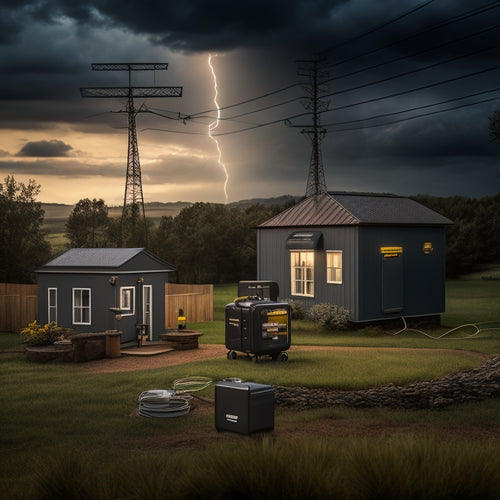
Roof Solar Panels With Battery Storage
Share
By integrating roof solar panels with battery storage, you'll reveal a reliable and cost-effective energy solution that reduces your reliance on the grid. You'll have power at night and during grid outages, while minimizing energy waste and optimizing energy usage for efficient management of your energy bills. With deep cycle batteries, you'll enjoy longer cycle life and reliable energy storage. As you investigate this sustainable energy solution, you'll want to evaluate factors like shading patterns on your roof, peak energy production hours, and the benefits of advanced battery technology, which will ultimately maximize your energy independence and savings.
The Essentials
- Roof solar panels with battery storage provide energy independence and reliability, ensuring power supply during nighttime and grid outages.
- Integration of solar battery storage systems reduces reliance on grid energy, leading to cost savings and optimized energy usage.
- High-efficiency solar panels and advanced batteries maximize energy potential, allowing for utilization of solar power beyond peak hours.
- Combining solar panels with deep cycle batteries enhances energy storage capabilities, promoting sustainability and supporting clean energy generation.
- Accurate shading analysis is crucial for optimal solar panel placement, considering seasonal variations in shading due to sun angle changes.
Energy Independence at Night
You've invested in roof solar panels to reduce your reliance on the grid, but what about powering your nighttime needs?
By integrating a solar battery storage system into your setup, you can store excess energy generated during the day and access the full potential of renewable energy. This means you can say goodbye to energy waste and have more control over your energy bills.
When the sun sets, you'll need a way to store excess energy generated during the day for use after dark. Your energy independence at night depends on a reliable system that can provide power when you need it most.
Powering Your Nighttime Needs
Energy independence takes on a new dimension at night, when the sun's rays no longer energize your roof solar panels. You're still in control, thanks to your battery storage system. With nighttime efficiency in mind, your energy management system optimizes energy distribution to meet your needs.
| Energy Needs | Solution |
|---|---|
| Evening Peak Hours | Your battery storage system kicks in, providing power for your lights, appliances, and devices. |
| Overnight Energy Requirements | Your system guarantees a steady supply of energy, even when the sun isn't shining. |
| Backup Power | In case of a grid outage, your battery storage system acts as a backup, keeping your home powered. |
| Energy Savings | Your system optimizes energy usage, reducing your reliance on the grid and lowering your energy bills. |
Energy After Dark Falls
Frequently, homeowners wonder how their roof solar panels will continue to power their homes after the sun sets. The answer lies in energy storage. With a battery storage system, you can store excess energy generated during the day for nighttime usage. This means you can enjoy the freedom of using your appliances, lighting, and electronics without relying on the grid.
In fact, a high-quality house solar battery can optimize your energy consumption, reducing your reliance on the grid and giving you greater control over your energy costs Renewable Energy. When the sun goes down, your energy storage system kicks in, providing a seamless shift to stored energy.
During the day, your solar panels generate electricity and feed it into your home. Any excess energy is redirected to your battery storage system, where it's stored for later use. As the sun sets, your energy storage system takes over, providing power to your home.
This allows you to maintain your energy independence, even in the dark. With energy storage, you can rest assured that your nighttime needs are met, giving you the freedom to live life on your own terms. By combining roof solar panels with energy storage, you can enjoy a reliable, sustainable, and independent energy solution.
Reduced Energy Waste
By installing roof solar panels, you'll optimize energy harvesting and minimize grid reliance.
This means you'll generate power when you need it, reducing the amount of energy wasted during transmission and distribution.
By switching to renewable energy sources, you'll not only reduce your carbon footprint but also take advantage of energy efficiency, which can lead to significant long-term savings.
With this setup, you'll maximize your energy independence while minimizing your reliance on the grid.
Optimize Energy Harvesting
Throughout your roof solar panel system, optimizing energy harvesting is vital to minimize energy waste and maximize your return on investment. You want to guarantee that every photon of sunlight is converted into usable energy.
To achieve this, it's important to focus on solar panel efficiency. Modern solar panels have improved considerably, with high-efficiency models capable of converting up to 22% of sunlight into electricity.
Additionally, advancements in battery technology have enabled more efficient energy storage and release.
Minimize Grid Reliance
As you focus on maximizing your roof solar panel system's energy harvesting capabilities, you'll also want to evaluate the benefits of minimizing grid reliance. By reducing your reliance on the grid, you can minimize energy waste and enhance your system's performance.
With advanced battery technology, you can store excess energy generated during the day for use during the night or on cloudy days, reducing your dependence on the grid.
Minimizing grid reliance also reveals various solar incentives, such as net metering, which allows you to sell excess energy back to the grid and offset your energy costs.
Effective energy management is vital in achieving this goal, and installation considerations, such as system sizing and orientation, play a significant role. With a well-designed system, you can enjoy significant cost savings, reduce your environmental impact, and experience a smoother user experience.
Regular system maintenance is essential to maintain peak performance, and staying up-to-date with future trends in battery technology and energy management will help you stay ahead of the curve.
Deep Cycle Battery Benefits
You'll want to contemplate deep cycle batteries for your roof solar panel system because they offer a longer cycle life, which translates to a longer lifespan and reduced maintenance costs.
With residential solar batteries, homeowners can enjoy a more reliable and efficient energy storage solution.
Additionally, these batteries provide increased energy capacity, allowing you to store more power for later use.
This means you'll have a reliable source of energy even during periods of low sunlight or power outages.
Longer Cycle Life
A well-maintained deep cycle battery can deliver an outstanding 5,000 to 7,000 charge cycles, far surpassing the 200 to 300 cycles offered by standard batteries. This means you can depend on your solar panel system to provide power for an extended period without worrying about battery replacement.
With a longer cycle life, you'll experience reduced maintenance costs and less waste, giving you more freedom to enjoy your renewable energy system.
The secret to achieving this extraordinary battery longevity lies in efficient charging. Deep cycle batteries are designed to handle the heavy demands of renewable energy systems, and their advanced technology guarantees they can handle the charging and discharging cycles with ease.
This results in a longer lifespan, reducing the need for frequent replacements and minimizing your environmental footprint. By investing in a high-quality deep cycle battery, you're investing in a sustainable energy future that's both cost-effective and environmentally friendly.
Increased Energy Capacity
With deep cycle batteries, your solar panel system can store more energy than ever before, thanks to their increased energy capacity. This means you can capture more power from the sun during the day and store it for use during the night or on cloudy days.
As a result, you'll enjoy greater energy independence and reduced reliance on the grid. The increased energy capacity of deep cycle batteries also translates to sustainability benefits, as you'll be generating and using clean energy.
Financial savings will also add up, as you'll be reducing your energy bills and potentially even selling excess energy back to the grid.
Moreover, technology advancements in battery types have made them more efficient and affordable, with lower installation costs and minimal maintenance requirements.
Additionally, government incentives and favorable energy policies can help offset the costs of your solar panel system.
Check Your Roof's Shading Patterns
You'll want to identify any roof obstructions, such as vents, skylights, or chimneys, that could cast shadows on your solar panels, as well as nearby trees that may shed leaves or branches, affecting their performance.
For an efficient home solar power solution, it's crucial to think about the impact of shading on your solar panel's energy output, which can greatly reduce energy bills.
Additionally, you should contemplate how shading patterns will change over time due to the sun's angle and the growth of surrounding vegetation.
Roof Obstructions and Trees
Check your roof's shading patterns to identify potential obstructions before installing roof solar panels.
You'll want to evaluate your roof's orientation and its impact on solar access. A south-facing roof with little to no shading is ideal, but not always possible.
Take note of any obstructions, such as skylights, vents, or chimneys, that could cast shadows on your solar panels.
Trees are another common obstruction to take into account. If you have trees nearby, assess their height, location, and growth pattern.
Will they grow taller and cast more shade in the future? Think about trimming or removing trees that could impact your solar panel's performance.
You may also want to reflect on the time of day and year when the trees cast the most shade. For example, if a tree casts shade only during the winter months when the sun is lower in the sky, it may not greatly impact your solar panel's performance.
Shading Patterns Over Time
Shading patterns on your roof can vary considerably over time due to the changing position of the sun. As the Earth rotates and orbits the sun, the angle and intensity of sunlight hitting your roof change. This affects the amount of energy your solar panels can generate.
To get an accurate depiction of your roof's shading patterns, you'll need to conduct a shading analysis. This involves evaluating the impact of seasonal variations on your roof's shading. During the summer months, the sun is higher in the sky, resulting in less shading. In contrast, during the winter months, the sun is lower, causing more shading.
Shading analysis software can help you visualize and quantify these variations. By inputting your roof's dimensions, orientation, and surrounding obstacles, the software can generate a detailed report on your roof's shading patterns over time.
This information is essential for ideal solar panel placement and ensuring maximum energy output.
Higher Capacity Peak Hours
You'll want to maximize your roof solar panels' energy production during peak hours when the sun is highest in the sky.
This typically occurs between 9 am and 3 pm, depending on your location and the time of year.
During these peak hours, your solar panels should be capable of producing maximum power, typically around 90% to 100% of their rated capacity.
Max Power During Peak
Peak hours in solar energy harvesting typically occur when the sun is highest in the sky, usually between 9 am and 3 pm. During this time, you'll want to maximize your solar panel's power output to charge your batteries and power your home.
To achieve this, you'll need a system that can handle the increased energy production. This is where high-capacity solar panels and innovative battery technology come into play. By combining high-efficiency solar panels with state-of-the-art battery technology, you can guarantee that your system operates at maximum capacity during peak hours.
You'll want to look for solar panels with high solar efficiency ratings, typically above 20%. These panels will convert more sunlight into usable energy, giving you more power during peak hours.
Additionally, consider batteries with advanced technology, such as lithium-ion batteries, which offer higher energy density and faster charging times. By pairing these components, you'll be able to utilize the full potential of your solar panel system during peak hours, giving you the freedom to power your home with clean, sustainable energy.
Frequently Asked Questions
How Long Does a Typical Roof Solar Panel System Installation Take?
You typically spend 2-5 days waiting for permits, then 1-3 days for installation, and another 1-2 weeks for inspections and connection, making the overall project duration around 3-6 weeks, depending on the installation timeline and local regulations.
Can I Use My Existing Electrical Panel With Solar Panels?
You'll need to assess your existing electrical panel's solar panel compatibility; if it's outdated or undersized, you'll require electrical panel upgrades to support the increased power output, ensuring a safe and efficient integration with your new solar panel system.
Are Roof Solar Panels With Battery Storage Eligible for Tax Credits?
You're wondering if solar power systems with battery storage qualify for tax credits; yes, they do! The Solar Investment Tax Credit (ITC) allows you to claim a credit of 26% of the total cost, including battery storage benefits, enhancing your energy independence.
Can I Add More Battery Storage Capacity in the Future?
When considering future upgrades, you can expand your battery capacity options, allowing you to store more excess energy generated; this flexibility enables you to adapt to changing energy needs, providing greater independence and control over your power supply.
Do Roof Solar Panels Void My Roof's Warranty?
You're not alone in worrying about roof warranty considerations; surprisingly, most roof manufacturers won't void your warranty due to solar panel installation, as long as the installation meets their specified requirements and doesn't cause damage to the roofing material.
Final Thoughts
As you flip the switch on your roof solar panels with battery storage, imagine yourself as a modern-day alchemist, turning sunlight into gold - or rather, electricity. With energy independence at night, reduced energy waste, and deep cycle battery benefits, you're utilizing the power of the sun like never before. By checking your roof's shading patterns and maximizing capacity during peak hours, you're not just generating electricity - you're forging a sustainable future.
Related Posts
-

How to Achieve a Zero-Waste Lifestyle for a Greener Tomorrow
To achieve a zero-waste lifestyle, start by adopting the principles of refusing, reducing, reusing, and recycling. Sw...
-

Key Components of a Reliable Emergency Power Supply System
A reliable emergency power supply system requires several key components. You need proven performance metrics to guar...
-

Solar Powered Lights for Sustainable Home Decor
Solar-powered lights offer a stylish and eco-friendly way to enhance your home decor. They capture sunlight, converti...


